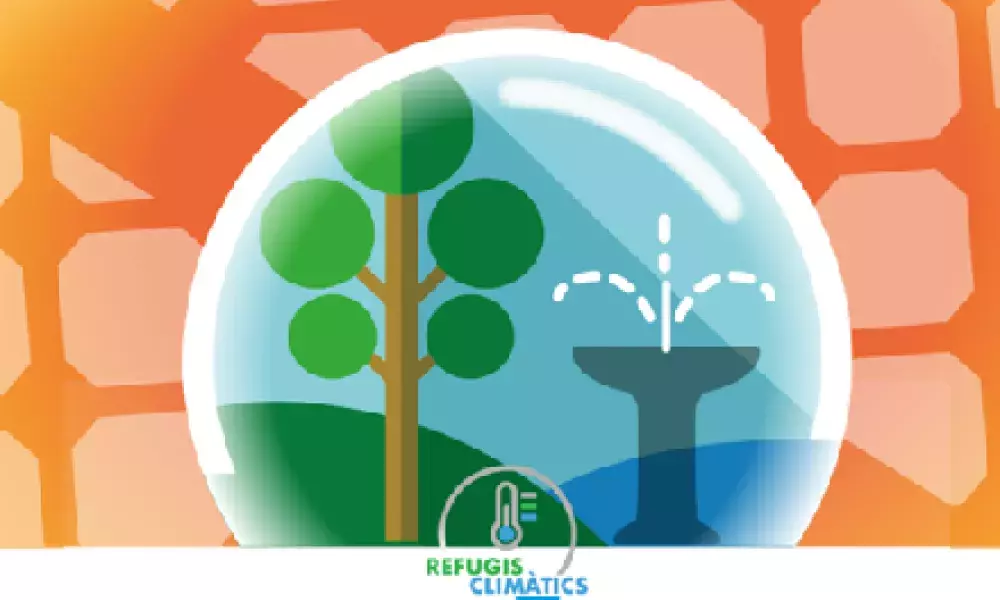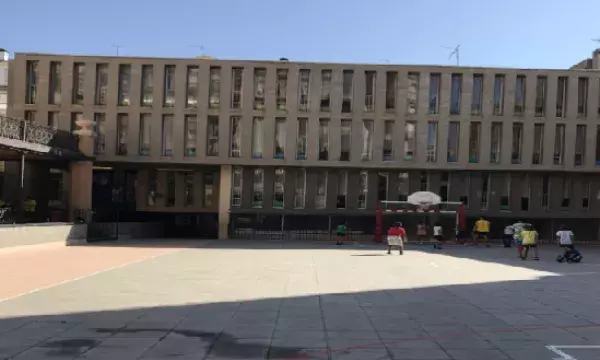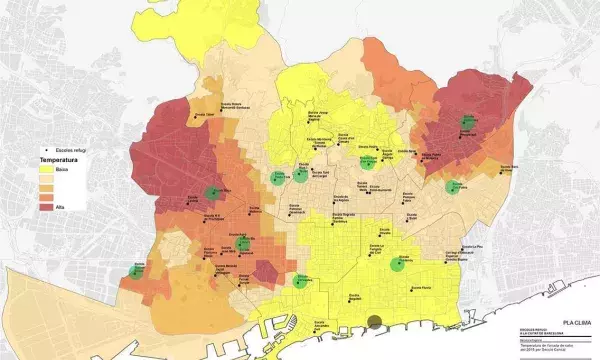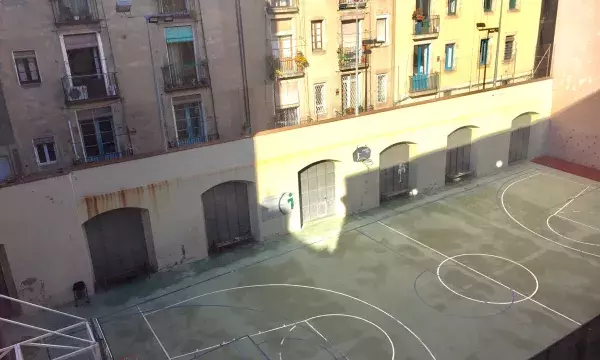
The heat is on
It is only 10 am but air temperature in Barcelona is already high; another heat wave has hit the city, causing the further enhancement of the heat island effect (i.e. when higher temperatures are recorded in a city as compared to rural areas) to which the city is already exposed. Citizens of all ages, especially the more vulnerable ones at ages less than 6 years and over 65 years old, are exposed to excessive heat, with negative consequences to their health.
Practically, and despite the benefits of the all famous Mediterranean climate, the city feels the combined effects of urbanization (which results in anthropogenic heat production) and climate change (which increases air temperature and makes heat waves more frequent and intense).
More heat to come
The reality for Barcelona, as for the vast majority of cities in southern Europe, especially in the Mediterranean Basin, is that climate predictions for the year 2050 foresee higher temperatures as much as 2.8 to 3.2 degrees Celcius as compared to present conditions, although for the worst case climate scenario. They also foresee roughly 20 additional hot days (over 30 degrees Celcius) for the year 2050, a fact which will expose citizens and visitors to adverse climatic conditions with potentially severe health impacts.
Not just an environmental challenge
To take not to the environmental challenge, the Barcelona City Council promotes an integrated city policy for adapting to climate change. The policy is aligned to such initiatives within the European Commission as the Covenant of Mayors for Climate and Energy and the Urban Agenda Partnership for Climate Adaptation. In particular, the signatory cities to the Covenant of Mayors, have endorsed a shared vision for 2050 also in view of strengthening their capacity to adapt to unavoidable climate change impacts.
The policy of the Barcelona City Council, also aligned to the Paris Agreement, is based on a mix of plans, the most notable ones being the Barcelona Climate Plan, the Energy, Climate Change and Air Quality Plan, the Barcelona Green Infrastructure and Biodiversity Plan, the Tree Master Plan (2017-2037) and the Action Plan for Preventing the Effects of Heat Waves on Human Health.
The Barcelona Climate Plan aims in particular to mitigate the effects of climate change, adapt the city, promote climate justice and foster citizen participation. A critical challenge of the Plan is how to protect people from high temperatures while at the same time improve the overall climate resilience of the city.
Needless to say, the challenge is also social, in the sense that measures to be promoted need to also support climate justice and thus social cohesion at the city level.
Think out of the box
Barcelona’s answer to overheating also includes an innovative pilot project to adapt schools to Climate Change, with the aim to develop a network of Climate Shelters around the city. The project has a duration of 3 years and is supported by the Urban Innovation Actions (UIA) of the European Commission.
Naturally an answer to overheating is green areas. But does the city have enough green areas? And if not, are there enough open spaces to be converted to green areas?
To this end, climate shelters are areas within the schools (practically their school yards) which by hosting blue, green and grey technical measures support the adaptation of the city to climate change. At the same time, the exposure of the school population to urban heat is ameliorated, whereas the possibility for the continuous use of the climate shelters by the wider public in non-school periods and throughout the year, is provided.
A typical image of a school yard to be converted to a climate shelter follows. The yard as it looks today, develops high temperatures due to the type of construction materials and the lack of greenery.

Escola Poeta Foix
Once the Climate Shelters project is implemented, approximately 4500 kids will benefit from the pilot measures in their schools, 3000 square meters of schoolyards will be transformed and 4500 square meters of urban green areas will be added.
The project also foresees its up scaling to more schools, a prospect of great importance for the city’s efforts to adapt to climate change and take care of the well being of the city residents in terms of heat prevention.
Summer in the city is hot, but some neighborhoods suffer more
Climate change impacts vary per city district, taken that they depend on such factors as the state - and consequently the thermal vulnerability - of buildings, the presence, extent and type of vegetation, the percentage of impermeable surfaces, the urban density, the dispersion of heat sources and the prevailing socio-economic conditions.
In Barcelona, areas differ with respect to the difference of their air temperature to the city's average. In particular, highest daytime temperatures are recorded in Les Corts, Eixample Esquerra, Nou Barris and Ciutat Vella, while the areas with the lowest temperature are next to the coast, thanks to the regulatory effect of the sea. However, at night the situation is reversed, with the highest temperatures recorded on the coast.

Air temperature differences from average for Barcelona.
The city is not just looking for climate interventions addressing a singular environmental challenge, in this case heat; it is rather seeking resilience interventions with multiple benefits for the school community and the public in general. To this end, social and inclusion issues are also considered.
“With a little help from my friends” – a wide city partnership
The Climate Shelters project is based on a partnernship coordinated by the Barcelona City Council (Area of Urban Ecology, Energy Agency, Municipal Institute of Urban Planning and Barcelona Municipal Institute of Education), with the participation of the Public Health Agency of Barcelona, the Barcelona Institute for Global Health, the Barcelona Education Consortium, the Barcelona Cycle of Water, the Institute of Environmental Science and Technology and last, but not least, the Vila Olimpica School.
Each of the partners has a distinct – yet complementary - role in the project. For example, Monica Ubalde, an expert from the Barcelona Institute for Global Health, notes “We are installing sensors to monitor the concentrations of air pollutants in the indoor and outdoor environment of the selected schools; the scope is to assess whether the measures to be implemented in the school environment within the Climate Shelters project, result in improvement to air quality.”
Science in support of policy making
Choosing the appropriate blue, green and grey technical measures for school yards to turn into Climate Shelters may seem simpler than in reality. For instance greenery in schools is one step forward, yet it is not always sufficient. In addition, measures to be promoted in one school do not necessarily have the same impact to another school, as local urban and microclimatic conditions vary. The message to be taken on board is that one solution does not fit all.
In the case of the Climate Shelters project, scientific knowledge (provided by the Agencia d’ Energia de Barcelona with the support of the Societat Organica) was taken good note in drafting the mix of technical measures for each of the schools of the network. According to Pere Munné from the Barcelona Education Consortium “a green wall here, a water point there, more areas of shade and drainable concrete surfaces that can absorb water when it rains, reflect some of the measures to be taken into consideration.”
Selecting schools – an environmental and social experiment
Environmental and social challenges were taken note in the drafting of the criteria (either mandatory or priority ones) for selecting schools. Mandatory criteria referred to the number of schools per district of Barcelona (1 per district, 10 in total), the type of school (public) and the educational level (primary).
Priority criteria included, among others, the state of environment in the area of the school (location of the school in a zone of maximum vulnerability to climate change, a zone of high air pollution, a zone with limited greenery), the building (exposure, thermal insulation and energy efficiency), the patio (the conditions of the playground in terms of the type of pavement, the sun exposure and the presence of water) and the risk for social exclusion.
An example of considerable interest is the ground yard of one of the selected schools (Escola Cervantes). The proximity of the yard to the neighboring buildings reflects the high urban density of the area as well as the potential of the Climate Shelter to accommodate the neighborhood in the event of excessive urban heat.
Forty five (45), out of one hunder and sixty (160) schools in Barcelona, expressed their interest by means of a motivation letter and committments to be taken on board once the school was selected. Ten (10) schools were selected, forming along with the Escola Villa Olimpica (partner of the project), the network of 11 schools of the Climate Shelters project.

School yard of the Escola Cervantes
Synergies with other school projects are also facilitated. Criteria also aimed to link the schools to running projects of the City of Barcelona, such as the Sustainable Schools and the Open School Yards. In this way, projects were intelinked, the one gaining from the experience from the others.
Schools in the frontline
An innovation of the Climate Shelters project was the participatory process for the selection of the most appropriate blue, green and grey measures per school. Schools were given ample space to express their interest and ambitions.
According to Maria Marqués, Director of the Vila Olimpica School “It was fun to design what my school needs to become a climate shelter. We do not have the expertise, but we were able to reflect the school’s conditions and place the suggested solutions in some kind of priority.”
Attention was also given to social issues, thus demonstrating the potential of schools to contribute to social cohesion, especially taking note of migration issues and the need to integrate migrants to city life and operations.
We are a multinational school with kids from over 60 nations. We applied a participatory process so as to communicate the Climate Shelters project to the parents and convince them on its benefits for the well-being of the students and the neighborhood residents.
Raising awareness
For all reasons to be considered, the project has a strong communication pillar. According to Monica Beneyto, communication officer from the Barcelona City Council for the Climate Shelters project “Raising the awareness of the public to the impacts of climate change and explaining how important is for the city to innovate and implement solutions to adapt to climate change, is a critical prerequisite for the success of the project. If citizens are motivated, the chances to recognize the merit of the network of the eleven climate shelters are high; in this case, the upscaling potential of the project is very promising.”
For further information regarding the Climate Shelters project, you may visit https://www.barcelona.cat/barcelona-pel-clima/en/climate-shelters-schools
About this resource
The Urban Innovative Actions (UIA) is a European Union initiative that provided funding to urban areas across Europe to test new and unproven solutions to urban challenges. The initiative had a total ERDF budget of €372 million for 2014-2020.
Similar content




